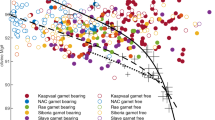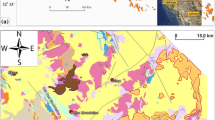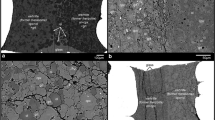Abstract
Experiments designed to simulate the dissolution of alkali feldspar during magma mixing produced plagioclase mantles that are texturally and compositionally similar to those in some hybrid volcanic rocks. In hydrous dacite melt (69% SiO2) at 0.8 GPa, 850°C, orthoclase (Or93) and sanidine (Or30) partially dissolved and were mantled by sodic plagioclase (∼An25–30). Although plagioclase nucleated epitaxially as a thin shell on the alkali feldspar surface near the time of initial resorption, plagioclase subsequently grew inward —mostly in the form of parallel blades — toaard the receding dissolution surface. Orthoclase dissolved at a rate approximately proportional to the square root of run duration, indicating diffusional control. Plagioclase grew inward within a static “boundary zone” of melt that formed between the original crystal-dacite interface and the dissolution surface. During orthoclase dissolution, this boundary zone rapidly and simultancously gained Na (by diffusion from dacite) and lost K (by diffusion into dacite); Ca diffused more slowly into this zone, from which non-feldspar species were mostly excluded. Plagioclase was stable where sufficient Ca had diffused in that the boundary zone melt intersected the plagioclase-saturation liquidus. Plagioclase subsequently grew toward the receding dissolution surface as the Ca compositional gradient (and hence the site of plagioclase saturation) stepped inward. Crystallization of plagioclase in the form of parallel blades allowed continued diffusive exchange of melt components between the dissolution surface and the host melt. Bladed growth also served to maintain (at blade tips) proximity of plagioclase to the dissolution surface, thereby apparently preserving (locally) a thin zone of low-variance melt. In natural systems, mantling of alkali feldspar by plagioclase will occur in a similar manner when (a) P, T, or X are changed to induce alkali feldspar dissolution, (b) sufficient Ca is available in the host melt to drive (by diffusion) boundary zone melt compositions to plagioclase saturation, and (c) temperatures are low enough to stabilize sodic plagioclase and to maintain a coherent boundary zone. These reqjirements are satisfied in volcanic systems when alkali feldspar is juxtaposed during mixing with hybrid melts of ∼dacitic composition. Mantled feldspars in some intrusive systems (i.e., “rapakivi granites”) may form by a similar dissolution- and diffusion-controlled mechanism. Textural evidence of a similar origin may be obscurred in intrusive rocks, however, by products of late-stage magmatic and subsolidus processes.
Similar content being viewed by others

References
Ayers JA, Brenan JB, Watson EB, Wark DA, Minarik W (in press) A new capsule technique for hydrothermal experiments using the piston cylinder. Am Mineral
Baker D (1990) Chemical interdiffusion of dacite and rhyolite: hydrous measurements at 1 atm and 10 kbar, applications of transition state theory, and diffusion in zoned magma chambers. Contrib Mineral Petrol 104:407–423
Baker D (1991) Interdiffusion of hydrous dacitic and rhyolitic melts and the efficacy of rhyolite contamination of dacitic enclaves. Contrib Mineral Petrol 106:462–473
Bussy F (1990) The rapakivi texture of feldspars in a plutonic mixing environment: a dissolution-recrystallization process? Geol J 25:319–324
Cherry ME, Trembath LT (1978) The pressure quench formation of rapakivi texture. Contrib Mineral Petrol 68:1–6
Dempster TJ, Hutton DHW, Harrison TN, Brown PE, Jenkin GRT (1991) Textural evolution of the rapakivi granites, south Greenland — Sr, O and H isotopic investigations. Contrib Mineral Petrol 107:459–471
Ellston JN (1985) Rapakivi texture: an indication of the crystallization of hydrosilicates, II. Earth Sci Rev 22:1–92
Glazner AF, Ussler WIII, Mies JW (1988) Fate of granitic minerals in mafic magmas. Eos 69:1504
Hibbard MJ (1981) The magma mixing origin of mantled feldspars. Contrib Mineral Petrol 76:158–170
Lofgren G (1974) An experimental study of plagioclase crystal morphology. Am J Sci 274:243–273
Nekvasil H (1991) Ascent of felsic magmas and formation of rapakivi. Am Mineral 76:1279–1290
Ortoleva P, Merino E, Moore C, Chadam J (1987) Geochemical self-organization I: reaction-transport feedbacks and modeling approach. Am J Sci 287:979–1007
Selderholm JJ (1891) Über die finnländischen Rapakiwigesteine. Tschermak's Mincral Petrogr Mitth 12:1–31
Stimae JA (1991) Evolution of the silicic magmatic system at Clear Lake, California, from 0.6 to 0.3 Ma (PhD dissertation). Queen's University, Kingston, Ontario, Canada
Stimae JA, Pearce TH (in press) Textural consequences of largescale mafic-felsic magma interaction: evidence from dacite lavas at Clear Lake, California. Am Mineral
Stimac JA, Wark DA (in press) Mantled-feldspar textures in Clear Lake (CA) volcanic rocks and implications for the origin of rapakivi granitcs. Bull Geol Soc Amer
Volborth A (1962) Rapakivi-type granites in the Precambrian Complex of Gold Butte, Clark County, Nevada. Bull Geol Soc Amer 73:813–832
Wark DA (1991) Role of mafic and intermediate-composition magmas in rhyolite genesis northern Sierra Madre Occidental, Mexico. J Geophys Res 96:13389–13412
Wark DA, Kempter K, McDowell F (1990) Evolution of waning, subduction-related magmatism, northern Sierra Madre Occidental, Mexico. Bull Geol Soc Amer 102:1555–1564
Watson EB (1982) Basalt contamination by continental crust: Some experiments and models. Contrib Mineral Petrol 80:73–87
Whitney JA (1975) The effects of pressure, temperature, and XH 2 O on phase assemblages in four synthetic rock compositions. J Geol 83:1–31
Yoder HS Jr, Stewart DB, Smith JR (1957) Ternary feldspars. Carnegie Inst Washington Yearbook 56:206–217
Zhang Y, Walker D, Lesher CE (1989) Diffusive crystal dissolution. Contrib Mineral Petrol 102:492–513
Author information
Authors and Affiliations
Rights and permissions
About this article
Cite this article
Wark, D.A., Stimac, J.A. Origin of mantle (rapakivi) feldspars: experimental evidence of a dissolution- and diffusion-controlled mechanism. Contr. Mineral. and Petrol. 111, 345–361 (1992). https://doi.org/10.1007/BF00311196
Received:
Accepted:
Issue Date:
DOI: https://doi.org/10.1007/BF00311196



